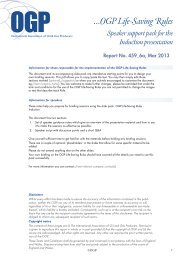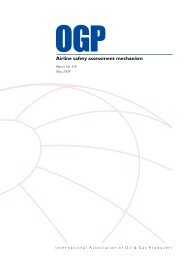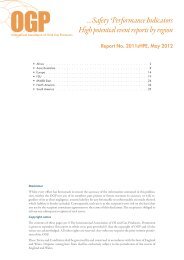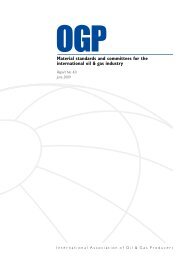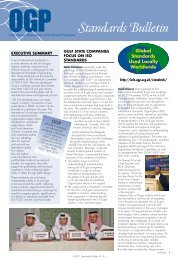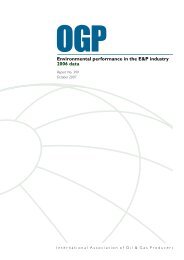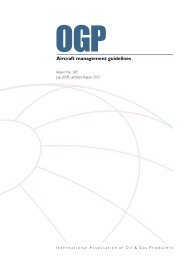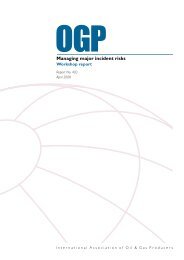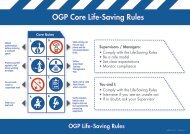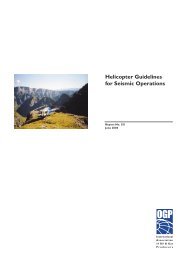Helicopter guidelines for land seismic & helirig operations - OGP
Helicopter guidelines for land seismic & helirig operations - OGP
Helicopter guidelines for land seismic & helirig operations - OGP
You also want an ePaper? Increase the reach of your titles
YUMPU automatically turns print PDFs into web optimized ePapers that Google loves.
International Association of Oil & Gas Producers<br />
B.1 Design definitions and standards<br />
Note: Slings, rigging hardware and other items of lifting equipment, manufactured by recognized<br />
and reputable sources, should comply with recognized international or country standards and<br />
should meet, as a minimum, the guidance in this publication.<br />
B.1.1<br />
Working load limit (WLL): WLL is the maximum working load (or <strong>for</strong>ce) a product<br />
is authorized to support when the pull is applied in-line, unless noted otherwise, with<br />
respect to the centerline of the product. The WLL of a component is specified by the<br />
manufacturer.<br />
Note: The actual load on a sling will depend on the configuration in which it is used. Only <strong>for</strong><br />
single (vertical) sling configuration will the load on the sling equal the weight of the load attached.<br />
Even then, the effective weight of the load will increase during acceleration and banking. Slings<br />
with a diagonal or slant configuration (e.g., a four-point attachment to a basket) will be subject<br />
to significantly larger <strong>for</strong>ces than the mere weight of the load. This must be taken into account in<br />
the design of multi-point sling configurations. ASME B30.9, Chapter 9-2 has useful tables <strong>for</strong><br />
calculating loads on slings of different types and in various configurations.<br />
B.1.2<br />
B.1.3<br />
B.1.4<br />
Design breaking strength: the design breaking strength (also called minimum<br />
breaking strength) is the load at which a new or unused rope, cable or structural<br />
strand could be expected to break when loaded to destruction in direct tension.<br />
Breaking strength is usually the optimum strength achieved under laboratory<br />
conditions, in accordance with prescribed test procedures, on new rope, pulling at<br />
a slow, steady rate in a straight line. Field use of lifting equipment normally involves<br />
many different types of <strong>for</strong>ces and factors which may cause the lifting equipment to<br />
fail at much reduced loads. Accordingly, the working load limit of any rope is much<br />
lower than its breaking strength.<br />
Design factor: The design factor is the ratio between nominal or minimum breaking<br />
strength and the rated capacity (WLL) of a component (sling, rigging hardware,<br />
etc.). The design factor is sometimes referred to as the “safety factor”. Simply put,<br />
dividing the breaking strength of a rope, cable or sling by the designated design<br />
factor results in the WLL. Two important terms from the definition of design factor<br />
are “nominal strength” and “minimum breaking strength.” Nominal is a term that<br />
relates to breaking strengths published by the Wire Rope Technical Board. This is<br />
the minimum breaking strength that a wire rope can have. A wire rope may break<br />
at a value greater than nominal, but never less. Design Factors have been established<br />
by OSHA, by ASME, by the American National Standards institute (ANSI), and<br />
similar government and international industrial organizations.<br />
Proof testing: A non-destructive load test made to a specific multiple of the rated load<br />
(WLL) of a component.<br />
B.2 Practical application<br />
B.2.1<br />
Working load limit (WLL): the WLL of any item of external lifting equipment<br />
should be equal to or greater than the maximum lifting capacity of the cargo hook.<br />
It should be noted that breaking strengths, when published, were obtained under<br />
controlled laboratory conditions. Listing of the breaking strength does not mean the<br />
WLL should ever be exceeded.<br />
46<br />
© <strong>OGP</strong>



